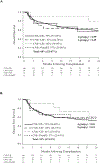Augmenting Total Body Irradiation with a Cranial Boost before Stem Cell Transplantation Protects Against Post-Transplant Central Nervous System Relapse in Acute Lymphoblastic Leukemia
- PMID: 29191665
- PMCID: PMC6692175
- DOI: 10.1016/j.bbmt.2017.11.013
Augmenting Total Body Irradiation with a Cranial Boost before Stem Cell Transplantation Protects Against Post-Transplant Central Nervous System Relapse in Acute Lymphoblastic Leukemia
Abstract
The purpose of this study was to determine the effect of a pretransplant cranial boost (CB) on post-transplant central nervous system (CNS) relapse and survival in acute lymphoblastic leukemia (ALL) patients undergoing allogeneic hematopoietic stem cell transplantation (HSCT) using a total body irradiation (TBI)-containing preparation regimen. Two hundred thirteen ALL patients were treated consecutively at our institution with allogeneic HSCT. Conditioning included TBI (1320 cGy in 8 fractions given twice daily) and cyclophosphamide (120 mg/kg) with or without fludarabine (75 mg/m2). Patients were divided into 4 groups based on history of CNS disease and whether a CB was given. Of the 160 patients with no history of CNS disease, none received a CB (CNS-/CB-). Of the 53 patients with prior CNS disease, 41 had not received prior cranial irradiation. Thirty of these 41 received a CB of 900 to 1000 cGy in 5 daily fractions (CNS+/CB+), whereas the other 11 did not receive a CB because of physician preference (CNS+/CB-). The remaining 12 patients with prior CNS involvement had previously received cranial irradiation and thus were not candidates for a CB (CNS + PriorRT). Two-year CNS relapse risk, overall survival (OS), and disease-free survival (DFS) were calculated using Kaplan-Meier analysis. Seven patients experienced post-transplant CNS relapse: 4 in the CNS-/CB- group, 2 in the CNS+/CB- group, and 1 in the CNS + PriorRT group. None of the 30 patients who received a CB relapsed in the CNS. Two-year CNS relapse risk was 0% in the CNS+/CB+ group compared with 21% (95% CI, 0% to 45%) in the CNS+/CB- group (P = .03). Two-year OS and DFS did not differ between the groups. In conclusion, among ALL patients with prior CNS leukemia, there was a trend toward a reduced risk of post-transplant CNS relapse in patients who received a CB. However, the addition of a CB did not appear to have an impact on OS or DFS.
Keywords: Acute lymphocytic leukemia; Allogeneic hematopoietic stem cell transplantation; Central nervous system relapse; Cranial boost; Total body irradiation.
Copyright © 2017 The American Society for Blood and Marrow Transplantation. Published by Elsevier Inc. All rights reserved.
Conflict of interest statement
Conflicts of Interest: none
Figures


References
-
- Hourigan MJ, Goldstone AH. Acute Lymphoblastic Leukemia: Epidemiology In: Advani AS, Lazarus HM, eds. Adult Acute Lymphocytic Leukemia: Biology and Treatment. Totowa, NJ: Humana Press; 2011:77–87. doi:10.1007/978-1-60761-707-5_6. - DOI
-
- Kamps WA, Bökkerink JPM, Hakvoort-Cammel FGAJ, et al. BFM-oriented treatment for children with acute lymphoblastic leukemia without cranial irradiation and treatment reduction for standard risk patients: Results of DCLSG protocol ALL-8 (1991–1996). Leukemia. 2002;16(6):1099–1111. doi:10.1038/sj/leu/2402489. - DOI - PubMed
Publication types
MeSH terms
Substances
Grants and funding
LinkOut - more resources
Full Text Sources
Other Literature Sources

